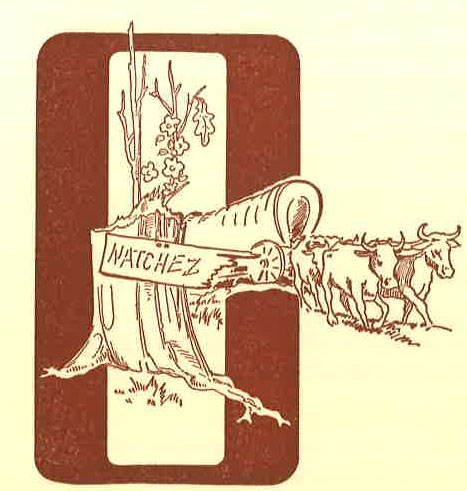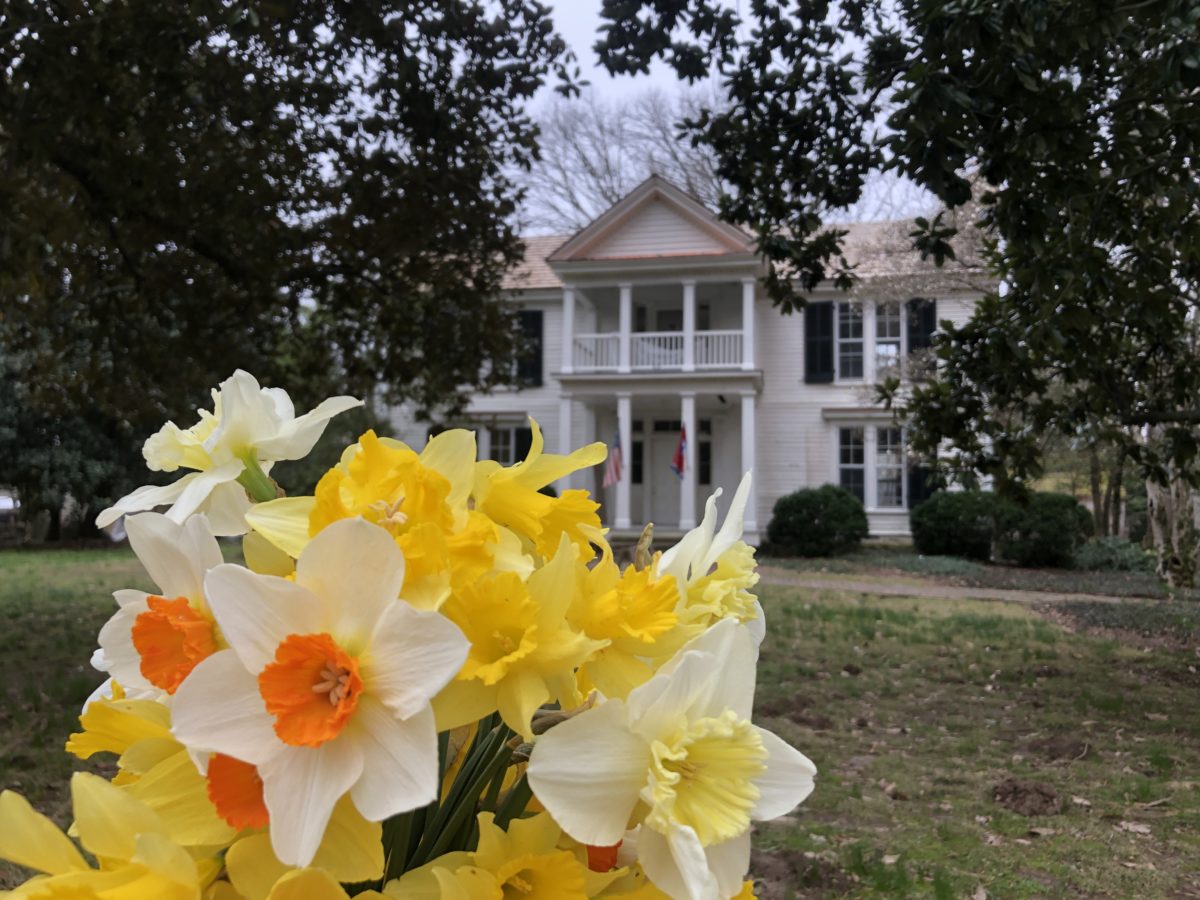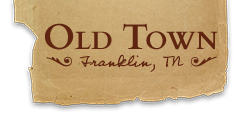Stories recorded by former Old Town owners Henry and Virginia Goodpasture
“Old Town stayed in the hands of the Brown family continuously-from 1840 to 1913 and part of the lands until 1928. It is stated by a granddaughter of Tom Brown that he owned at the place, 150 slaves. The farm now contains an extensive graveyard marked by simple headstones of pieces of limestone rock, where many slaves are buried.”
Henry and Virginia Goodpasture, Old Town, 1950, p. 11.

“Tom Brown had a famous dapple gray saddle mare named “Slasher.” Many stories are told of this re markable horse. When the Yankees would come, foraging for horses, the gallant “Slasher” with mane and tail standing out would lead the horses at a fast gallop back into the hills where they would be safe from capture. On one occasion when a troop of Union Cavalry was passing in front of the house, Grandmother Brown held Slasher under the bridge where she would be out of sight of the troops and by gently caressing her nose kept her from making any sound until the horsemen were safely passed.”
Henry and Virginia Goodpasture, Old Town, 1950, p. 15.
“On another occasion, a man referred to as “A homemade Yankee” (which referred to a Southerner who for mercenary reasons was a Yankee sympathizer) was apprehended in the act of leading Slasher out of the barn lot. Grandmother Brown and her daughter Bethenia ran tearfully out and asked permission to tell Slasher goodbye. The man leading Slasher had a hand kerchief over his face to hide his identity. While Bethenia was affectionately caressing Slasher she gently undid the throat latch and with a quick movement jerked the bridle off of Slasher who galloped rapidly to the hills.”
Henry and Virginia Goodpasture, Old Town, 1950, p. 15.
“It was commonly understood amongst the Confederate Troops that food was always available at Old Town. A code was worked out by which rocks were placed on the gateposts indicating a point on the farm at which food might be found. Grandma Brown and Bethenia would ride back into the hills with baskets of food to a rendezvous known only to Confederate soldiers.”
Henry and Virginia Goodpasture, Old Town, 1950, p. 15-16.
“In the early days of the war Grandpa Brown hid a large accumulation of gold under the house. A slave boy observed him emerge from under the house and promptly thereafter the slave boy and the gold simultaneously disappeared and neither has been seen nor heard from since.”
Henry and Virginia Goodpasture, Old Town, 1950, p. 16.
“Dr. Alfred Leland Crabb has penned some lines about Old Town in which he says:
‘Unmarred by newness is the place,
No modern smirk upon its face.
So fair it stands, untouched by years
A witness of the pioneers.
True founders all, bathed by the sun
Who loved the land that they had won
And built great homes to ease the stress
Of lives lived in the wilderness.
“The years have come and quickly fled,
And now the founders all are dead.
New founders come and blessed are they,
Who save old landmarks from decay,
Who give their thought and work and gold
To add new graces to the old,
So that a noble home may be
Endowed with perpetuity.’”
Henry and Virginia Goodpasture, Old Town, 1950, p. 17-18.
“About 1945 we began looking at “Old Town,” a farm down the road from Orchard Gate about a mile and a half south on the Natchez Trace. This was a beautiful and historic home built about 1845, a two story house which sat in a lovely grove of trees surrounded by Indian mounds. It was a famous Indian graveyard which was written about in most magazines and books that dealt with that subject. The house had a great deal of charm and was surrounded by a beautiful farm. I developed a great yen for this place and went over there many week ends to see it. There was a great old friend of ours there that we called “Uncle Joe” Livingston who was a real estate man who had charge of it and he ran the farm. The owner of the farm was away in the Army at that time. I took Virginia out a number of times and she enjoyed it but insisted that she would not want to live that far out in the country but I finally got her permission to buy the place. We went out and spent week ends and had a lot of fun. I moved the livestock and horses over from Orchard Gate farm and later sold Orchard Gate. The Harpeth River went in front of Old Town. We had a canoe and enjoyed boating and swimming. After about three years after Ken graduated from Montgomery Bell Academy and entered Davidson College I finally persuaded Virginia to agree to let us move to Old Town. We then sold Hood’s Hill Road, with sadness and reluctance, having had so many happy years there. But our life at Old Town was a happy and joyous affair. It was a mecca for our friends who came from every direction and we entertained a great deal. Anna Bell loved the place and made it quite easy for us to entertain our friends there. We lived there for 30 years. We later built a beautiful swimming pool and we and our friends enjoyed that. We had many fruit trees, flowers and two or three hundred boxwoods. The farm included usually Willie, “the weeper” and Ammon and his wife Mary Ann, and we lived there very happily.”
Goodpasture, Henry, Memoirs of Henry Goodpasture, 1979, page 53.
“In 1948 we moved to historic Old Town, a farm, near Nashville. We had restored a house built in 1840 in the center of an ancient town of pre-historic, stone grave mound builders. The amount of work involved in such a move would have staggered anyone with less and fortitude than Anna Bell. But with Willie the Weeper as an indefatigable helper we finally got the through the ordeal of moving and were delightfully settled in new surroundings with sparkling windows, waxed floors, polished brass, a new kitchen and a great out-of-doors which Anna Bell deeply appreciated and enjoyed. Our fences were not too good. The cattle or horses got out occasionally but with her usual alertness they were discovered and recaptured. She kept an eye on the farm help and got along well with them. She soon knew the neighbor farmers and when they came by served them coffee. She was popular with all serving men whom we got from town to help with parties. She engaged and directed them. She helped on the farm when needed, supervised garden planting and when we were short of help at haying time I have come home from my law offices in the late afternoon and found Anna Bell in overalls and a big straw hat on top of a load of hay. She ministered to sick animals, rode herd with a shotgun on marauding dogs, foxes and snakes.”
Goodpasture, Henry, Memoirs of Henry Goodpasture, 1979, page 73.
Stories from Historic Williamson County by Virginia Bowman

“In 1801, when the Secretary of the War ordered the Trace widened to facilitate the passage of mail and troops between Natchez and Nashville, a new bridge was built over Donelson Creek at Old Town. Though not in use since 1913, the old bridge stands as a picturesque monument to the skill of early stone masons and as an excellent example of early American bridge construction. Over this bridge passed Andrew Jackson and his army on the way to New Orleans. Over its wooden floor horses’ hooves and carriage and wagon wheels clattered for generations. It was forty years old when Thomas Brown began construction of the homeplace.”
Bowman, Virginia McDaniel. “Old Town.” Historic Williamson County, Blue & Gray Press, Nashville, 1971, p. 92.
“For the building of the residence at Old Town, Pryor Lillie, the contractor, used slave labor and materials from the site. All yellow poplar and longleaf pine timbers were hand sawn and joined with pegs and square headed nails. When completed, it was a sturdy two-story frame dwelling with a small two-story porch and was located some eight miles northwest of town.”
Bowman, Virginia McDaniel. “Old Town.” Historic Williamson County, Blue & Gray Press, Nashville, 1971, p. 93.
“While in residence here Captain and Mrs. Miller’s small daughter Mary Minor fell from the upstairs porch and lived a little hunchback until her death in 1883 at the age of six. Because there was a doctor in the vicinity who had evidenced much curiosity over the child’s injury and was not above grave robbing, the little grave near the house was covered by a shelter where a lantern burned all night. When Old Town went out of the family, Mrs. Brown’s grave in Mt. Hope was opened and the little casket placed there.”
Bowman, Virginia McDaniel. “Old Town.” Historic Williamson County, Blue & Gray Press, Nashville, 1971, p. 93.
Stories from the letter collection of Bethenia Brown Miller
Description: Handwritten letter in brown ink on blue-lined cream colored foolscap stationery. Dated October 16, 1859. Written to Mr. J.T. Brown. From his father Thomas Brown, River Side at Home.
“Beauford died on Tuesday one week after you left. He went of something like the other 2 Pointers. Your uncle George has come home much [page torn] better. I have not seen him. They [page torn] have, says he is nearly well. This is Wednesday 19th heavy frost this morning for the first to bite. I have got about 12,000 pounds of cotton out I think I will make about 30,000 pounds from present prospects. Pumpkins to any amount. Corn very light. Your mother and sisters joins in love. And I join upon you to keep yourself clear from anything that will defile. Remember my admonitions my son, Yours as Ever and Father, Tho Brown”
Description: Handwritten letter in brown ink on blue-lined foolscap white colored stationery. Written to Miss Thenia. Dated September 4, 1861. From R. H. Garden.
“I am glad to know that the young ladies take so much interest in the Volunteers. It makes all of them feel a great deal braver, to know that they have such true, and patriotic ladies at home, whom they are called upon to defend and protect. And you can rest assured that not one of the cowardly Yankees can place his polluted feet upon the sacred soil of the South, until every drop of blood which courses through the veins of every member of the ‘Walker Legion’ is spilled upon Valley, hill, and dale.”
Description: Handwritten letter in brown ink on blue-lined cream colored stationery. Written to Miss B.A. Brown. Dated January 7th, 1964. From J. Thos. Brown. Camp Morton POW Camp. Sad reflections of a prisoner.
“All seem to think we will soon be removed from here to Butler’s department but I suppose you know more about what’s going on that I do as we receive no papers at all. (no papers allowed to come in) Times are very dull and dreary now, being housed for a week every saying and act has become old and uninteresting in fact all seem to have the ‘blues.’ I for one sit for hours and think of home and call to memory every happy moment of the past and compare them to the present. Never will I catch a bird or anything living and cage it, for I now by experience know the horrors of imprisonment.”
Description: Handwritten letter in brown ink on blue-lined while colored stationery. Written to My Dear Sister. Dated February 23, 1865.
“I have a great deal to tell you, but cannot think of a single word now. Every word which I utter seems to echo ‘You’re exchanged’ and with those words ringing in my ear I am too happy to say or do anything but Amen! Amen! Just the idea of being free once more makes me perfectly crazy to reach that land of freedom – I never thought anything could excite me so much.”
Description: Handwritten letter in brown ink on blue-lined white colored stationery. Written to Miss Thenia Brown. Dated Mary 9, 1865. POW prisoner letter.
“My Dear Friend, As I am in the last prison (I hope) into which I am likely to ‘break’ before passing through ‘the lines.’ I will write several letters to my friends at Franklin. After being confined for more than 5 weeks at that delightful place Camp Chase. I with nine other Surgeons include Foster, Sadler, Wilson and McMillan all of Franklin notoriety. Was paroled and started in charge of an officer for this place which we reached today about 3 o’clock.”
Stories about past Stewards of Old Town
“The name ‘Goodpasture’ holds much meaning for me, too. Not long after we moved here we rescued an abandoned and severely neglected old pony we named Jed. Catherine [Cooper] invited Jed to stay at Old Town to graze on the good pasture and rest is old bones on the Mississippian Indian mounds. During cold winters Jed was sheltered in the old red barn there. Years passed and Jed did too. He rests in a shady grove next to the good pasture alongside the Harpeth River. Now Jubilee, an old Appaloosa horse, grazed on the mounds. He is at home there with the Indians since his ancestors were bred by the Nez Perce Native Americans.”
Laura Turner, “Letter to the Editor: Goodpasture was good steward of Old Town,” The Tennessean, September 1999.

“In 2014, Maureen [Cromling] hired Dry Stone Conservancy of Lexington, Kentucky, to rebuild the north bridge abutment of the original limestone Old Town Bridge built in 1801 by U.S. soldiers. The Tennessee Preservation Trust received its first preservation easement from the Cromlings on the Old Town Bridge in 2015, calling the Old Bridge ‘one of the most significant structures in the state.’”
Laura Turner, “Letter to the Editor: Cromling leaves a wonderful legacy as matriarch of Old Town,” Williamson Herald, 18 July 2019.

“Maureen also planted daffodils when she was at Old Town, adding to the living legacy enjoyed by generations along the Old Natchez Trace. Lightning bugs still spark upon Old Town’s historic, scenic and culturally significant grounds. And I told Maureen many times I carry her in my heart as I walk Old Town and the Old Natchez Trace. Some people, like some places, transcend time and space.”
Laura Turner, “Letter to the Editor: Cromling leaves a wonderful legacy as matriarch of Old Town,” Williamson Herald, 18 July 2019.
